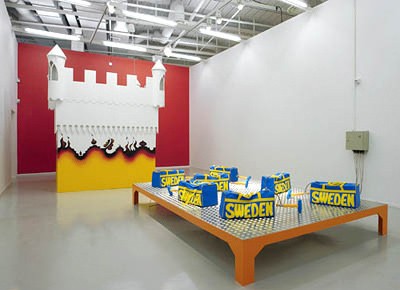
Peter Johansson, Peter Johanssons Udda veckor, 2003 © Peter Johansson/BUS 2012
Odd weeks: Peter Johansson
Whoopee!
10.3 2003 – 23.3 2003
Stockholm
In his art, he returns again and again to Dalarna, the county where he was born and bred. This is manifested in Dala Horses, sliced and packed in styrofoam and clingfilm, like meat in a supermarket, bird nesting boxes bunged up with Falukorv sausages, or Nazi uniforms embroidered like folk costumes. His works are often over-the-top and exaggerated. Bad taste, kitsch and entertainment are allowed to run amok.
In the early days of modern art, it was stipulated that ornamentation was a serious offence – a die-hard prohibition, it turned out. Therefore, Johansson’s curlicue kurbits decorations and ornamental carpentry are unexpected, folksy features. However, in the midst of this hearty joviality lies a darker resonance, a more serious undertone. Peter Johansson’s pill may be sugar-coated, but it is bitter all the same.
Dalarna has come to represent the quintessence of Swedishness. Carl Larsson and Anders Zorn were among the artists who created the image of this county as embodying the Swedish identity, not only in their paintings but perhaps just as much through the nationalist, romantic homes they built for themselves. Today, the tourist industry has taken over the promotion of Dalarna as the cradle of Sweden, where blonde locals (dalmasar) celebrate Midsummer among the white birch trees.
Is it a love-hate that prompts Peter Johansson to use his childhood region as the starting-point when attacking the issues of national identity that his work has revolved around so persistently since the late-1980s? Today, this Swedishness is changing, when 20% of the Swedish population have a foreign background. Nevertheless, the myth prevails that Sweden is so very homogeneous. Peter Johansson reveals how the construction of our national identity is often founded on exclusion.
A number of yellow-and-blue sport bags with Sweden printed on the side are stacked on a table. Each bag contains a plastic hammer that moves up and down. A cheery song, or rather, loud whoopees – like a made-up folk song – emanates from a fortress-like construction. Decorative flames of the type painted on the customised cars of raggare flicker round the base of the construction. Is the fortress on fire?
Curator: Magnus af Petersens
